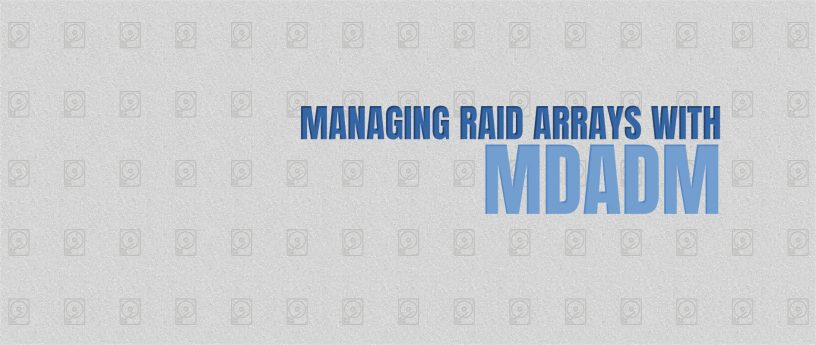5.2 KiB
Managing RAID arrays with mdadm
Mdadm stands for Multiple Disk and Device Administration. It is a command line tool that can be used to manage software RAID arrays on your Linux PC. This article outlines the basics you need to get started with it.
The following five commands allow you to make use of mdadm’s most basic features:
- Create a RAID array :
mdadm --create /dev/md/test --homehost=any --metadata=1.0 --level=1 --raid-devices=2 /dev/sda1 /dev/sdb1
- Assemble (and start) a RAID array :
mdadm --assemble /dev/md/test /dev/sda1 /dev/sdb1
- Stop a RAID array :
mdadm --stop /dev/md/test
- Delete a RAID array :
mdadm --zero-superblock /dev/sda1 /dev/sdb1
- Check the status of all assembled RAID arrays :
cat /proc/mdstat
Notes on features
mdadm --create
The create command shown above includes the following four parameters in addition to the create parameter itself and the device names:
- –homehost : By default, mdadm stores your computer’s name as an attribute of the RAID array. If your computer name does not match the stored name, the array will not automatically assemble. This feature is useful in server clusters that share hard drives because file system corruption usually occurs if multiple servers attempt to access the same drive at the same time. The name any is reserved and disables the homehost restriction.
- –metadata : mdadm reserves a small portion of each RAID device to store information about the RAID array itself. The metadata parameter specifies the format and location of the information. The value 1.0 indicates to use version-1 formatting and store the metadata at the end of the device.
- –level : The level parameter specifies how the data should be distributed among the underlying devices. Level 1 indicates each device should contain a complete copy of all the data. This level is also known as disk mirroring.
- –raid-devices : The raid-devices parameter specifies the number of devices that will be used to create the RAID array.
By using level=1 (mirroring) in combination with metadata=1.0 (store the metadata at the end of the device), you create a RAID1 array whose underlying devices appear normal if accessed without the aid of the mdadm driver. This is useful in the case of disaster recovery, because you can access the device even if the new system doesn’t support mdadm arrays. It’s also useful in case a program needs read-only access to the underlying device before mdadm is available. For example, the UEFI firmware in a computer may need to read the bootloader from the ESP before mdadm is started.
mdadm --assemble
The assemble command above fails if a member device is missing or corrupt. To force the RAID array to assemble and start when one of its members is missing, use the following command:
# mdadm --assemble --run /dev/md/test /dev/sda1
Other important notes
Avoid writing directly to any devices that underlay a mdadm RAID1 array. That causes the devices to become out-of-sync and mdadm won’t know that they are out-of-sync. If you access a RAID1 array with a device that’s been modified out-of-band, you can cause file system corruption. If you modify a RAID1 device out-of-band and need to force the array to re-synchronize, delete the mdadm metadata from the device to be overwritten and then re-add it to the array as demonstrated below:
# mdadm --zero-superblock /dev/sdb1
# mdadm --assemble --run /dev/md/test /dev/sda1
# mdadm /dev/md/test --add /dev/sdb1
These commands completely overwrite the contents of sdb1 with the contents of sda1.
To specify any RAID arrays to automatically activate when your computer starts, create an /etc/mdadm.conf configuration file.
For the most up-to-date and detailed information, check the man pages:
$ man mdadm
$ man mdadm.conf
The next article of this series will show a step-by-step guide on how to convert an existing single-disk Linux installation to a mirrored-disk installation, that will continue running even if one of its hard drives suddenly stops working!
via: https://fedoramagazine.org/managing-raid-arrays-with-mdadm/
作者:Gregory Bartholomew 选题:lujun9972 译者:译者ID 校对:校对者ID
